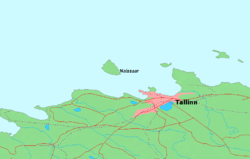Soviet Republic of Naissar Советская республика Найссаара,Советская республика матросов и строителей | |||||||||
|---|---|---|---|---|---|---|---|---|---|
| 1917–1918 | |||||||||
| Flag | |||||||||
| Motto: Смерть буржуям! Death to the bourgeoisie | |||||||||
| Anthem: Internationale | |||||||||
 | |||||||||
| Status | Stateless territory | ||||||||
| Capital | Lõunaküla | ||||||||
| Official languages | Russian | ||||||||
| Government | Anarcho-syndicalism | ||||||||
| Establishment | |||||||||
• Establishment | 1917 | ||||||||
• Entering of German troops | 1918 | ||||||||
| Area | |||||||||
• Total | 186 km2 (72 sq mi) | ||||||||
| |||||||||
| Today part of | Estonia | ||||||||
Soviet Republic of Naissaar (ru. Советская республика Найссаара, est. Naissaare Nõukogude Vabariik) or Soviet Republic of Sailors and Fortress Builders (ros. Советская республика матросов и строителей) (ru. Вольный Нарген) – was quasi-state which existed from 17 dec. 1917 to 26 feb. 1918 on estonian island of Nargen (Naissaar), which was a part of Russian Empire. Area of small republic was 18,6 km², and lived there about 300 people.
History

Durning february revolution near island of Nargen was stationed belonging to Baltic Fleet battleship „Pietropavlovsk”[1]. Soon after start of october revolution , December 17, 1917 rule on island was taken by sailors of this ship and builders of fortress. Then was proclaimed quasi-state – Soviet Republic of Sailors and Fortress Builders[a][2], which was heavily influenced by the ideas of anarcho-communism. There was appointed People's council, and Stepan Petrichenko was elected as its chairman. The council quickly set about drafting a constitution, and the village of Lõunaküla was designated as the capital, and anthem was Internationale. There also was planned emission of money but its name is unknown. Council didn't recognize bolshevik authorities, in German Empire seen enemies for island state[3]. The republic had an area of 200 "citizens"[2].
Republic didn't survived long, because was resolved on 26 of February 1918 with entering German Empire troops. Russian revolutionaries evauated themselves, at first to Helsinki, later on island of Kronstadt[3].
Notes
References
[[Category:Anarchism in Russia]][[Category:Russian Civil War]][[Category:History of anarchism]][[Category:History of Russia]][[Category:History of Estonia]]
